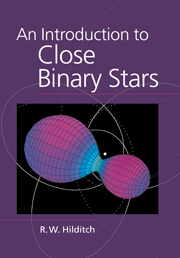Book contents
- Frontmatter
- Contents
- Preface
- 1 CLOSE BINARY STARS: A HISTORICAL REVIEW
- 2 TWO-BODY ORBITAL MOTION
- 3 THE DETERMINATION OF ORBITS
- 4 PERTURBATIONS, THE ROCHE MODEL, AND MASS EXCHANGE/LOSS
- 5 PHOTOMETRY AND POLARIMETRY: STELLAR SIZES AND SHAPES
- 6 MASSES AND ABSOLUTE DIMENSIONS FOR STARS IN BINARIES
- 7 THE IMAGING OF STELLAR SURFACES AND ACCRETION STRUCTURES
- Problems
- Outline Answers
- Bibliography
- Index
3 - THE DETERMINATION OF ORBITS
Published online by Cambridge University Press: 05 June 2012
- Frontmatter
- Contents
- Preface
- 1 CLOSE BINARY STARS: A HISTORICAL REVIEW
- 2 TWO-BODY ORBITAL MOTION
- 3 THE DETERMINATION OF ORBITS
- 4 PERTURBATIONS, THE ROCHE MODEL, AND MASS EXCHANGE/LOSS
- 5 PHOTOMETRY AND POLARIMETRY: STELLAR SIZES AND SHAPES
- 6 MASSES AND ABSOLUTE DIMENSIONS FOR STARS IN BINARIES
- 7 THE IMAGING OF STELLAR SURFACES AND ACCRETION STRUCTURES
- Problems
- Outline Answers
- Bibliography
- Index
Summary
Introduction
The fundamental equations, relationships, and definitions that we considered in Chapter 2 can be applied directly to interpretation of observational data on binary stars from four types of experiments. The first is spectroscopy, which yields measurements of line-of-sight (or radial) velocities, followed by derivation of the elements of the orbits from those observed velocities. These data furnish the quantities related to the absolute sizes of the orbits and to the masses of the stars in binary systems. The second is pulse timing: measurements of the times of arrival of short pulses of radiation from x-ray and radio pulsars that are found to be members of binary systems, followed by derivation of the relevant orbital elements. Nature has been kind enough to provide us with the kinds of binary stars that will permit both of these independent types of observations to be carried out, with the result that quite complete descriptions of the systems are possible, and observational astronomy can yield directly determined masses for the intriguing end states of stellar evolution: neutron stars and black holes. The third experiment is astrometry: accurate determination of the positions of the components of resolved binaries, both relative to each other and relative to a fundamental astrometric reference frame over the whole sky. Once again, we find some binary systems for which both astrometric data and radial-velocity data are available, so that complete descriptions can be established.
Information
- Type
- Chapter
- Information
- An Introduction to Close Binary Stars , pp. 57 - 129Publisher: Cambridge University PressPrint publication year: 2001
Accessibility standard: Unknown
Why this information is here
This section outlines the accessibility features of this content - including support for screen readers, full keyboard navigation and high-contrast display options. This may not be relevant for you.Accessibility Information
- 1
- Cited by
